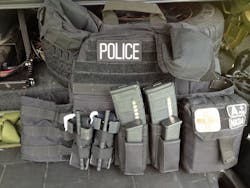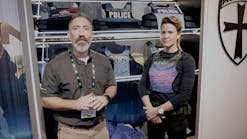Gone are the days where we felt secure wearing our Level 2 soft armor to any call for service. The use of plate carriers by police and responsible citizens is on the rise. You might be asking why. Simply, a lot of yesterday’s soldiers are ending their time in service and know just how beneficial plate carriers can be. They are bringing that knowledge back to the streets in the US and passing it on to others.
Plate carriers are a great thing because you can dump that “Active Shooter” bag in your cruiser for a plate carrier to help you carry the same equipment but you also provide yourself with better ballistic protection. We are talking about the kind of ballistic protection that was once reserved for SWAT. You can put a plate carrier on right over top of your uniform shirt and move out smartly toward your objective. Most plate carriers come with MOLLE or PALS webbing on the front & back as well as the cummerbund. You can attach any number of pouches to the carrier. For example, you could have extra rifle and pistol magazines, shotgun shells, an Individual First Aid Kit (IFAK), utility pouch with glow sticks, door chocks, nutrition bars, and a gas mask pouch. Attach a hydration system to the back and you pretty much have what you need for an extended engagement.
With that said, you can’t just go buy a plate carrier and some “RIFLE THREAT” plates and go out expecting it to stop all rifle threats. The best thing you can do is contact the manufacturer of your soft vest and ask them what hard armor plates will protect you from rifle threats weather you’re looking to stop regular ball ammo or true “High Hard” armor piercing.
I am going to try and cover the levels of protection as simply as I can. There is no substitute for actually contacting an armor dealer or manufacturer for technical specifications. A lot of the lighter weight plates are meant to be used in conjunction with NIJ Level 3A soft armor. That doesn’t mean you can get any Level IV plate and use it with any Level 3A soft armor. Frequently, plates are meant to be used with a particular model of soft armor to properly provide the level of protection advertised.
For the most part, patrol is wearing Level 2 soft armor and unless the manufacturer states otherwise, that is not going to give you the protection you need against rifle level threats when paired with a “Rifle Threat” plate, You’re going to need to look at “STAND ALONE” plates that are not required to be used in conjunction with NIJ Level 3A soft armor. The down side to “Stand Alone” plates is the weight; they are considerably heavier but that’s the price you’re going to have to pay if you’re not wearing Level 3A soft armor.
In case you’re curious, the Holy Grail for protection offered by hard plate armor is the ability to stop .30-06 M2 Armor Piercing (Black Tip) ammunition with a “High Hard” steel core penetrator. This is what military ESAPI (Enhanced Small Arms Protective Insert) plates are designed to stop but to offer that level of protection, they are to be used in conjunction with soft armor. The military also has their own set of testing protocols for certifying armor; they do not use NIJ standards.
Let’s be clear about something, the majority of rifle ammunition you are going to encounter is not true armor piercing. True armor piercing ammo with a “High Hard” core is rare and very expensive. One type of ammo you are highly likely to encounter is surplus M855 “Green Tip” 5.56 mm. This ammo is sold as having a penetrator but it is not “High Hard” and therefore considered by the military and law enforcement to be ball ammo.
Here are the current standards of Protection for NIJ 0101.06.
Soft Armor:
- IIA: 9mm FMJ and .40 S&W
- II: 9mm FMJ and .357 mag.
- IIIA: .357 Sig and .44 magnum
- III: (Usually hard armor plate) 7.62x51mm M80 ball
- IV: (Usually hard armor plate) .30-06 M2, AP (Armor piercing)
A lot of agencies are purchasing plate carriers for their personnel. Some agencies are approving their use and mandate which model plate carrier and plates you can purchase. Some have no policy and leave it up to the individual officer. Just like everything else in the world, you get what you pay for. Try to check out what other officers are using, do some research on line, talk to your military friends and try to determine what will work best for you based on price, features, comfort, and durability. Prices are all over the chart for plate carriers. I have one that only cost me a little over $100 and one that cost almost $600. There is definitely a difference. I wore a plate carrier pretty much every day when I was assigned to a fugitive apprehension unit. That justified the use of a more expensive carrier, plus my agency bought it for me so I got very lucky. If I was only buying a plate carrier to keep on hand in the event of an active shooter or well armed, barricaded subject, I wouldn’t spend more than $200 on a carrier. You’re just not going to use it enough to get your money’s worth out of it.
Since I’ve got a couple plate carriers and have tested a few, I know some key features to look for. First and foremost, shoulder straps that once they are adjusted aren’t going to loosen up on you. Do not get anything that uses elastic in the shoulder straps. The elastic will cause sag. Depending on the model you get, you’ll need someone to help you adjust the straps while you wear the carrier with your plates in and gear attached. Next, padding for the shoulder straps is a requirement. These things get heavy very quickly and will start working on you before to long. Finally, the cummerbund should be adjustable and have MOLLE webbing. Typically, the cummerbund adjustment is accomplished by loosening shock cord laces in the back. Be careful when placing pouches on your gun side. You don’t want anything to interfere with your draw. For those of you working in maritime environments, there are plate carries available that have flotation systems available as well as pull cords to dump your carrier in an emergency. Plate carriers with that feature are going to be more expensive obviously.
I frequently see people wearing plate carriers that are not properly adjusted. They are being worn way to low and aren’t providing the maximum amount of protection. The front plate should be worn so that the top of the plate is at the top of your sternum. The rear plate should be a mirror image. People typically will overlook the placement of the rear plate. Don’t overlook sizing of the plate carrier itself also. There are a few so called “Universal Size” plate carriers. These are okay but, if you can swing the money for one that is sized to you, you’ll be more comfortable.
While on the topic of sizing, there are different sizes plates available. Those sizes include:
- Small-7 ¼ x 11 1/2" inches
- Medium-3 ¾ x 11 ¾ inches
- Large-10 1/8 x 13 ¼ inches
- Extra Large-11 x 14 inches
Torso side protection plates are also available. Side plates can interfere with your draw and may require the use of a drop leg holster. Side plates usually measure 6 x 8 inches or 6 x 6 inches.
In the end, plate carriers are a great tool as long as you set them up properly. They offer enhanced protection and enhanced operational capability. Do your homework; see what works for you, and make sure you train with your plate carrier. Participating in training will help you with determining gear placement. Gear placement is a big issue. I always like to see if I can get to all my gear with my strong hand but also with my support hand.
More than likely, you’re going to have difficulty getting your pistol out of a strong side hip holster when wearing a plate carrier. I fixed that particular problem by carrying an agency approved back up gun on the front of my carrier. I carry mine in a holster equipped with a quick disconnect system. Don’t forget to consider retention if placing a back up gun on the front of your carrier. You’re now defending two firearms. For that reason, I do not recommend carrying two handguns and a long gun. As a matter of fact, it is in my agency’s policies and procedures that no officer will carry anymore than two firearms at any one time.
Another important item is your IFAK and tourniquet. You should be able to get to either item with both hands in the event you need to render self aid. Training can help you learn your limitations and help you know what to expect when using shoulder fired weapons. Yes, shooting shoulder fired weapons will feel much different and will probably require the use of collapsible shoulder stocks that allow adjustment for length of pull. You may also find that some styles of rifle slings work better with plate carriers than others. Slings can get caught up on the gear easily. To save you the trouble, I find that single point slings work best when using a plate carrier even though I prefer a quick adjust two point sling.
This article was written with assistance from Adam Williamson, owner of Contra Threat Sciences, an independent ballistics consulting company. For more information about Contra Threat Sciences, visit their web page at: http://contrathreat.com/

Max Schulte
Max Schulte is a Nationally Registered EMT-Paramedic that is also an 22 year veteran of law enforcement with 5 years spent on active duty as a US Army Military Policeman. His duties included patrol, Special Reaction Team, SRT Sniper, & Military Police Investigations. He is currently serving with a large law enforcement agency in Maryland where he has worked patrol, criminal investigations, fugitive investigations, and aviation. He is a field armorer for numerous weapon systems and an adjunct firearms instructor for his agency as well as several civilian firearms and tactics training companies.



